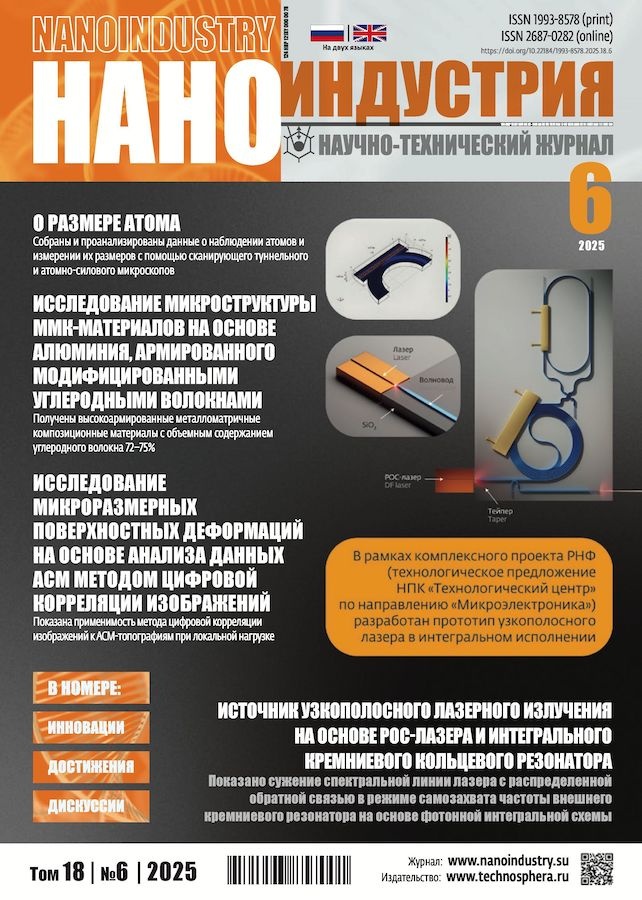About dimension of the atom
- Authors: Yaminsky D.I.1, Akhmetova A.I.1,2, Fedoseev A.I.1, Yaminsky I.V.1,2
-
Affiliations:
- Lomonosov Moscow State University
- Advanced Technologies Center
- Issue: Vol 18, No 6 (2025)
- Pages: 346-354
- Section: Nanotechnologies
- URL: https://journals.eco-vector.com/1993-8578/article/view/692440
- DOI: https://doi.org/10.22184/1993-8578.2025.18.6.346.354
- ID: 692440
Cite item
Abstract
In modern metrology, the size of an atom is determined statistically as half the interatomic distance in a crystal lattice, rather than through direct measurement of an isolated atom. Scanning tunneling microscopy (STM) and atomic force microscopy (AFM) are key tools for directly observing and measuring the geometry of individual atoms weakly bound to a substrate. The image obtained in STM is the spatial distribution of the electron density of the outer shell of the atom. Although STM is traditionally considered a more detailed method, AFM with modified probes can in some cases provide greater resolution and the ability to chemically identify atoms. In this article, we have collected data on the observation of atoms and their size measurements using scanning tunneling and atomic force microscopy.
Full Text
About the authors
D. I. Yaminsky
Lomonosov Moscow State University
Author for correspondence.
Email: yaminsky@nanoscopy.ru
ORCID iD: 0009-0009-6370-7496
Post Graduate, Physical Department
Russian Federation, MoscowA. I. Akhmetova
Lomonosov Moscow State University; Advanced Technologies Center
Email: yaminsky@nanoscopy.ru
ORCID iD: 0000-0002-5115-8030
Cand. of Sci. (Physics and Mathematics), Senior Researcher, Leading Specialist, Physical Department
Russian Federation, Moscow; MoscowA. I. Fedoseev
Lomonosov Moscow State University
Email: yaminsky@nanoscopy.ru
ORCID iD: 0009-0007-7282-1093
Doct. of Sci. (Physics and Mathematics), Prof., Physical Department
Russian Federation, MoscowI. V. Yaminsky
Lomonosov Moscow State University; Advanced Technologies Center
Email: yaminsky@nanoscopy.ru
ORCID iD: 0000-0001-8731-3947
Doct. of Sci. (Physics and Mathematics), Prof., Director General, Physical Department
Russian Federation, Moscow; MoscowReferences
- Cordero B. et al. Covalent radii revisited. Dalton Trans. 21. 2008. PP. 2832–2838. https://doi.org/10.1039/b801115j
- Crommie M.F. et al. Confinement of Electrons to Quantum Corrals on a Metal Surface. Science 262. 1993. PP. 218–220. https://doi.org/10.1126/science.262.5131.218
- Eigler D., Schweizer E. Positioning single atoms with a scanning tunnelling microscope. Nature. 1990. Vol. 344. PP. 524–526. https://doi.org/10.1038/344524a0
- Néel N., Kröger J. Orbital and Skeletal Structure of a Single Molecule on a Metal Surface Unveiled by Scanning Tunneling Microcopy. J. Phys. Chem. Lett. 2023. Vol. 14. No. 16. PP. 3946–3952. https://doi.org/10.1021/acs.jpclett.3c 00460
- Wallis T.M., Nilius N., Ho W. Erratum: Electronic Density Oscillations in Gold Atomic Chains Assembled Atom by Atom. Phys. Rev. Lett. 2002. Vol. 89. P. 236802. https://doi.org/10.1103/PhysRevLett.89.236802
- Sugimoto Y., Pou P. et al. Chemical identification of individual surface atoms by atomic force microscopy. Nature. 2007. Vol. 446. No. 7131. PP. 64–67. https://doi.org/10.1038/nature05530
- Wood J., Palms D. et al. Investigating Simulated Cellular Interactions on Nanostructured Surfaces with Antibacterial Properties: Insights from Force Curve Simulations. Nanomaterials (Basel). 2025. Vol. 15. No. 6. P. 462. https://doi.org/10.3390/nano15060462
- Gross L., Mohn F., Moll N., Liljeroth P., Meyer G. Science. 2023. Vol. 325. Iss. 5944. PP. 1110–1114. https://doi.org/10.1126/science.1176210
- Abilio I., Neel N. et al. Scanning tunneling microscopy using CO-terminated probes with tilted and straight geometries. Phys. Rev. B 110. 2024. P. 125422. https://doi.org/10.1103/PhysRevB.110.125422
- Lauhon L.J., Ho W. Direct Observation of the Quantum Tunneling of Single Hydrogen Atoms with a Scanning Tunneling Microscope. Phys. Rev. Lett. 2003. Vol. 85. Iss. 21. PP. 4566–4569. https://doi.org/10.1103/PhysRevLett.85.4566
- Yaminsky D., Yaminsky I. The standard of the nanometer. NANOINDUSTRY. 2009. Vol. 4. PP. 44–45.
- Akhmetova A.I., Terentyev A.D. et al. Diffraction grating as a means of metrological support of microscopy. NANOINDUSTRY. 2024. Vol. 17. No. 2. PP. 128–133. https://doi.org/10.22184/1993-8578.2024.17.2.128.133
- Akhmetova A.I., Sovetnikov T.O. et al. Quartz reference measure for scanning probe microscopy. NANOINDUSTRY. 2024. Vol. 17. No. 2. PP. 98–105. https://doi.org/10.22184/1993-8578.2024.17.2.98.105
- Heisenberg W. Über den anschaulichen Inhalt der quantentheoretischen Kinematik und Mechanik. Zeitschrift für Physik. 1927. Vol. 43. PP. 172–198.
- Müller E.W. Das Auflösungsvermögen des Feldionenmikroskopes. Zeitschrift für Naturforschung A. 1956. Vol. 11. No. 1. PP. 88–94. https://doi.org/10.1515/zna-1956-0116
- Crewe A.V., Wall J., Langmore J. Visibility of single atoms. Science. 1970. Vol. 168. PP. 1338–1340. https://doi.org/10.1126/science.168.3937.1338
- Formanek H., Müller M. et al. Visualisation of single heavy atoms with the electron microscope. Naturwissenschaften 58. 1971. PP. 339–344. https://doi.org/10.1007/BF00602786
Supplementary files










